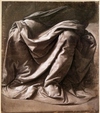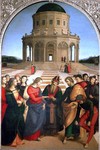Art History 1 Flashcards

Christ and Doubting Thomas
Andrea del Verrocchio
1467-83
bronze
Orsanmichele

Christ and Doubting Thomas
Made for Merchants Tribunal
Only niche with two statues, Thomas steps out (he is of the earth, Christ is of heaven)
Gilding and classical curls on Thomas
Demonstrates interest in anatomy, texture, use of hands for emphasis and drama

Bust of a Woman with Flowers
Verrocchio, late 1470s, marble
Same classic curls as Thomas, contrast between that texture and the smoothness of her face
Beautiful hands (different from earlier busts) drape her heart and stomach (feminie gestures)
draping and texture in garment

David
Verrocchio, bronze, 1473-75
gilded hair (same as Thomas)
Pre-teen boy build
agressive, cocky, beautiful

Baptism of Christ
Verrocchio and Leonardo Da Vinci
1472-75, oil on panel
Leonardo painted angel and background behind angels

Baptism of Christ (angels)
Leonardo painted angel looking toward Christ
Painted body to reflect the soul and mind
response to religious event (awe, reverence, love, faith)

Baptism of Christ
Background above angels (Leonardo)
Opticslly realistic
atmosphereic perspective

Martyrdom of St. Sebastian
Antonio del Pollaiuolo, mid-1470s, panel
study of anatomy and musculature

Annunciation
Leonardo, oil on panel, 1470s
Mary sits in corner (she is the foundation of the church)
Mary calm and dignified
reading Bible (symbolizes knowledge of future death), draped in cloth (alludes to the Mass)
meticulous drapery, same tiled floor as the museum the painting now resides in :)
misty harbor background (mysterious, the real world/earth is hazy and plain vs the clear and beautiful divine world)

Study of drapery
1470s
Similar to the drapery in Annunciation
Used to dip cloth in plaster and let dry to study drapery patterns and looks

Portrait of Ginevra de’Benci
Leonardo, mid 1470s, oil on panel, Wachington National Gallery
Still intersted in texture as well as how light and shadows touch the face
lines on the face blend into the shadows, become one
Her name means juniper, jumiper bushes behind her

Portrait of Ginevra de’Benci
Portrait was cut later, botom half would most likely have revealed Ginevra’s hands (similar pose to his Master Verrocchio’s bust)
back of the panel painted to look like porphyry (valuable stone= royalty, Roman allusion)
Juniper sprig + laurel= royalty, classical
Enscription praises her beauty
Beautiful forever: immportalised in her portrait

Adoration of the Magi
Leonardo, begun 1481, unfinished underdrwing on panel
Madonna and child in very center, create pyramid with figures beside, She is largest (hierarchal scale)
background figures create arch of emotion around her serenity
scene framed by old and young man (youth and wisdom represented (just like Jesus!))
Madonna heavy-lidded and thoughtful (similiar to Verrocchio)

Adoration of the Magi
Botticelli, panel, early 1480s
Similar figure positioning as Leonardo
Pyramid with Madonna and Child at the head

Study for Adoration
Leonardo, 1481, pen and ink
Tons of architecture that Leonardo latter omitted
vanishing point would have been behind Mary

Madonna of the Rocks
Leonardo, early 1480s, oil on panel, alterpiece for Franciscan church (Milan)
figures make pyramid; Jesus blessing John the baptist, but he is lower; Mary’s, angel’s, and Jesus’s hands in a linear formation; This arrangement of the figures is mysterious and up for debate
No vanishing point, background accurate to nature, but it is an imaginary place; sfumato- smoke-like -> lines in figures blend in and disappear into shadows, shading
chiaroscuro- light and dark
Mary’s expression is contemplative, prophetic; ponders and keeps her thoughts in her heart

Study for Angel (Madonna of the Rocks)
Leonardo, early 1480s, for S. Francesco Grande, Milan
silverpoint on paper
beautiful lines, less texture to hair
eyes knowing, divine: no way a human can decipher what an angel is thinking

Horseman Trampling Enemy (study for Duke Sforza)
Leonardo, drawing, 1485
largest bronze ever attmpted, bronze eventually striped for cannons, destroyed by French soldiers
enemy underneath horse is a new innovation by Leonardo

Portrait of Cecilia Gallerani
Leonardo, 1490, oil on panel
Duke Sforza’s mistress, holds white ermine (weasel)
demonstrates her name (Galleroni=weasel) and her lover’s status
Beautiful hands embrace ermine, turned to the side as if looking toward the Duke makes her smile
richly dressed, but not overly blinged-out, classy

The Last Supper
Leonardo, 1495-98, fresco painting mixed with oil, Refectory in Santa Maria delle Grazie (Dominican), Milan
figures demonstrate the drama, emotion after hearing that one of them will betray Jesus
Jesus is vanishing point, his position makes a small triangle, open hand towards bread (the body)

Last Supper
Sforza’s coat of arms, mulberries (Sforza’s nickname Il Moro)
Door cut into later (noooooooo!)
Oil and fresco doesn’t stick well to the wall= fresco deteriorating, repaitned/restored often

Last Supper (John, Peter, Judas)
They sit on Jesus’s right
Judas’s face doesn’t betray his evil, he reaches for the bread at the same time (in the Bible this gesture reveals him to be the traitor)
Leonardo chose to portray the reality of the scene: the disciples do not know he is the traitor yet! He still sits with them.

Last Supper
Ghirlandaio, 1480, fresco, Church of Ognissanti
Architectual obstacle makes fresco seem crowded (Leonardo solved by moving scene down)
Judas on other side of table, John asleep, Jesus is not in the middle!

Apostle Matthew (Last Supper)
Leonardo, red chalk, pen and ink, 1495
Livid expression, cannot beleive a disciple will betray Jesus
Classical curly hair like Thomas and David














































































